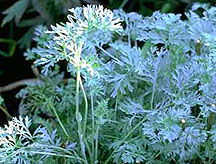
The end of the growing season is often a bittersweet experience for gardeners. It signals the end of months of work—but also marks the end of the splendid time when each day offers up something new, from the bold bloom of a rhododendron to the subtle emergence of flower heads on ornamental grasses.
The late-autumn and winter gardens do have their charms, and perennials can be very much a part of this four-season interest. While good garden tidiness dictates a thorough cleanup in the fall, there are some interesting plants that can be left standing, since even in their dormancy, they offer surprising delights for the discriminating eye.
The condition, stature, and overall appearance of plants in the winter depend greatly on how healthy they were during the growing season. Plants that were not watered during the drought or were attacked by disease or insects will surely not make worthy winter specimens. But healthy, well-tended plants, sited in their preferred environments, can turn out to be the unexpected treasures of the winter garden.
BLUE
For gardeners partial to blue plants, there are two selections of ornamental grasses that hold their blue color well into winter. Elijah Blue blue fescue (Festuca ovina glauca 'Elijah Blue') is the bluest of the fescues and retains its compact form all season. Blue oat grass (Helictotrichon sempervirens) grows taller, at 2 to 3 feet, and its stiff blue foliage will remain a true blue until early spring, when it should be pruned to the ground like other ornamental grasses.
SILVER
Any plant with blue, silver, or gray foliage must be planted in full sun in very well-draining soil or it will develop rot at the crown or in the roots. The low-growing cottage pink Dianthus gratianopolitanus 'Bath's Pink' has a strong reputation for resisting the "melting out" tendency of other silver-blue-foliaged plants. In spring, the pink-fringed flowers complement the slender blue-to-silver foliage; in winter, the blue foliage alone is the attraction. Artemisia stellerana 'Silver Brocade', the hardy dusty miller, features intense silver foliage in both summer and winter since it contrasts nicely with the bright green of boxwood or other smaller evergreens. Plant this lacy perennial where drainage is excellent.
YELLOW
Bright golden plants in winter are striking, especially when set against the darker foliage of plants with purple or green leaves. The creeping ground cover Veronica repens 'Sunshine' is a newer variety whose tiny mosslike leaves remain yellow all year. For a moist area, the golden sedge Carex elata 'Bowles Golden' will keep its color most of the winter. Its 2- to 3-foot arching golden leaves feature fine green margins.
BURGUNDY AND PURPLE
Plants with dark purple or burgundy foliage work well in perennial borders because nearby flowering plants with blue, pink, lavender, or yellow flowers show them to advantage. The extremely popular Heuchera, or coral bells, offers new dark-leaved hybrids annually, some of which retain their mottled purple leaves year-round. 'Plum Pudding' is such a plant. Its leaves are glossy burgundy with silver lines in the summer. In winter, the color remains but the shine departs.
ORNAMENTAL GRASSES
Grasses are key players in the late-fall and winter garden. The ones that retain their shape without collapsing under heavy snow loads or shattering their seedheads in midwinter are especially valuable. Northern sea oats (Chasmanthium latifolium), Karl Foerster feather reed grass (Calamagrostis x acutiflora 'Karl Foerster'), and most of the fountain grasses (Pennisetum alopecuroides) are favorites for four-season interest.
SEEDS
Many gardeners value the plants that bring in birds seeking out seeds. Purple or white coneflowers (Echinacea purpurea) are well known to goldfinches who perch on the rounded cones and peck away at the nutritious, oil-rich seeds. Cultivars of the native switchgrass Panicum virgatum produce tiny seeds that only the smallest birds can seize. And the other forms of coneflower, like the black-eyed Susan, (Rudbeckia spp.) are also favored by seed-eating songbirds. When left to dry naturally in the garden, these plants will add another dimension to what we once thought was a dormant season.


